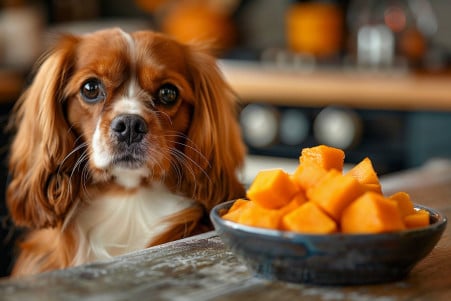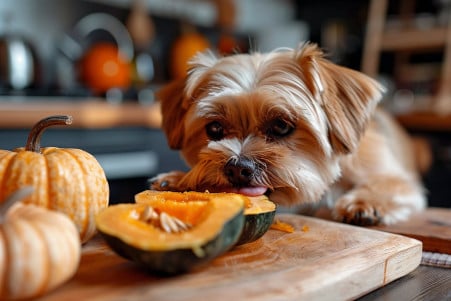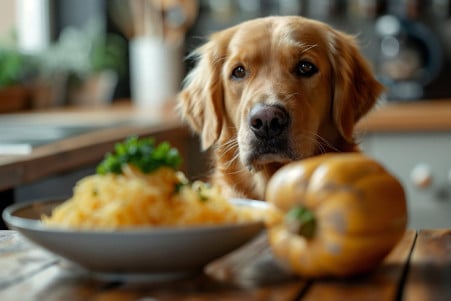Can Dogs Eat Yellow Squash? A Look at the Pros and Cons
30 April 2024 • Updated 30 April 2024

If you've ever found yourself with an abundance of yellow squash and a curious pup, you may have asked yourself if you can share this nutritious veggie with your dog. The good news is that yellow squash is perfectly safe for dogs and even offers some health benefits, such as vitamins A and C, fiber, and extra hydration. However, because of its high fiber content, it's important to remember that squash should be a small part of your dog's diet.
Although yellow squash can be a nutritious and delicious addition to most dogs' diets, it's always a good idea to consult your vet to make sure your dog doesn't have any allergies or sensitivities. Here's what the science says about the potential benefits and drawbacks of feeding your dog this bright yellow vegetable.
Can dogs eat yellow squash?
How to Prepare Yellow Squash for Dogs: Raw vs. Cooked
While yellow squash is a healthy option for your dog, raw squash is hard for dogs to digest and can cause digestive upset. Cooking is the best way to prepare squash for your dog since it breaks down the tough fibers and makes it easier for your dog to digest.
When cooking squash for your dog, make sure to avoid adding any seasonings, oils, or other ingredients that could be toxic to your dog. The best way to cook squash for your dog is to steam or boil it. You can also roast or bake it, but make sure not to add any salt, onions, garlic, or spices.
To make the squash easier for your dog to digest, mash or cut it into small, bite-sized pieces before serving. This will make it easier for your dog to chew and swallow. While squash can be a good source of fiber and vitamins, it should not be the only thing your dog eats. Make sure to feed it in moderation and as part of a balanced diet that meets your dog's individual nutritional needs.
Precautions When Feeding Your Dog Squash Seeds and Leaves
The seeds of yellow squash must be removed before feeding to dogs because they can cause digestive issues if eaten in large amounts. The Native Pet also states that the seeds and skin of winter squash are too fibrous for dogs and can cause an intestinal blockage.
Meanwhile, squash leaves should be avoided because they are high in fiber and can cause an upset stomach, vomiting, or diarrhea. Purrch Pets also warns that if dogs do eat squash leaves by accident, make sure they drink plenty of water and watch them for any signs of a reaction.
It's also important to buy yellow squash from reputable sources to avoid toxic compounds like cucurbitacin. According to Spoiled Hounds, cucurbitacin can be more prevalent due to a variety of factors, including poor growing conditions or cross-pollination with wild plants. This compound can cause symptoms such as vomiting, diarrhea, and dizziness in dogs.
Properly preparing and handling the squash can help ensure that it's a safe and healthy food for your dog. This includes removing the seeds, stem, and leaves and cooking the squash thoroughly to make it easier for your dog to digest.
How Much Yellow Squash Can Dogs Have?
The amount of yellow squash you can give your dog will depend on their size and dietary needs. Petful recommends that as a rule of thumb, no more than 10% of a dog's daily calories should come from squash. For dogs that weigh less than 10 lbs, give them less than a teaspoon of cooked, mashed squash. Dogs that weigh between 10-25 lbs can have about a teaspoon, while dogs that weigh between 25-60 lbs can have up to two teaspoons. Dogs that weigh between 60-100 lbs can have 1-2 tablespoons, and dogs that weigh over 100 lbs can have up to 3 tablespoons.
According to Dutch.com, it's best to feed your dog squash in moderation and increase the amount you give them based on their response. Make sure to check with your vet before you make any major changes to your dog's diet or introduce new foods like squash. It's important to feed your dog squash in moderation because too much of it can cause digestive issues because of its high fiber content.
Can Dogs With Diabetes Eat Squash?
Yellow squash is a good option for dogs with diabetes because it is low in calories and has a low glycemic index. The Holistic Vet and Pet Nutrition Journal explains that the fiber in squash can help with blood sugar control and digestive health. That said, it's important to remember that dogs with diabetes need to be fed in moderation, as overeating any food can cause blood sugar levels to rise.
Make sure to talk to your vet to find out how much and how often you should be feeding your diabetic dog squash. The journal also notes that you should keep a close eye on your dog's blood sugar levels when you're introducing new foods like squash. If you follow your vet's advice and keep an eye on your dog's blood sugar levels, you can feed your diabetic dog yellow squash as part of a healthy, balanced diet.
Conclusion: Feed Dogs Yellow Squash in Moderation
Yellow squash can be a safe and nutritious occasional treat for most dogs if it is fed to them in moderation. The American Kennel Club (AKC) notes that squash itself is safe for dogs to eat, "provided seeds, skin, and rinds have been removed."
However, it is important to prepare the squash properly by cooking it and removing the seeds and leaves. PetMD suggests cooking the squash lightly and without any seasoning and cutting the flesh into small, bite-sized pieces.
In addition, the amount of squash a dog eats should be limited, and it should not account for a large portion of their daily food intake. Daily Paws explains that the right amount of squash for a dog to eat depends on their size, with small dogs requiring only a few small cubes per meal.
It is also important to watch for any adverse reactions when feeding dogs new foods like squash and to talk to a vet if you have any concerns. If you take the right precautions and control the portion size, yellow squash can be a healthy part of a dog's well-rounded diet.


